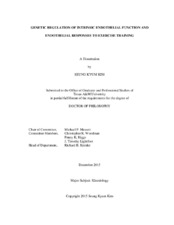| dc.contributor.advisor | Massett, Michael P | |
| dc.creator | Kim, Seung Kyum | |
| dc.date.accessioned | 2016-05-04T13:20:37Z | |
| dc.date.available | 2017-12-01T06:36:18Z | |
| dc.date.created | 2015-12 | |
| dc.date.issued | 2015-10-30 | |
| dc.date.submitted | December 2015 | |
| dc.identifier.uri | https://hdl.handle.net/1969.1/156421 | |
| dc.description.abstract | Endothelial dysfunction is a fundamental component of cardiovascular disease. Exercise training is known to prevent/improve endothelial dysfunction. However, the genetic basis for endothelial function is yet to be fully elucidated and the genetic contribution to endothelial responses to exercise training is largely unknown. The purposes of this research were 1) to identify quantitative trait loci (QTL)/candidate genes residing in the QTL responsible for intrinsic endothelial function and 2) to determine the interaction between genetic background and training intensity on the endothelial adaptations to exercise training. In the first study, vasoreactivity was assessed in aortic rings of male mice from 27 inbred strains. Strain-dependent differences were found for vasoreactivity including responses to ACh. Genome-wide association study for responses to ACh revealed four significant and several suggestive QTL, most of which are regions of shared synteny for cardiovascular traits in rats and/or humans. In the second study, a strain survey for the effect of traditional exercise training on vasoreactivity was performed in aortic rings of male mice from 20 inbred strains. Traditional exercise training had subtle effects on vasoreactivity including responses to ACh. Based on the strain survey, four inbred mouse strains (129S1, B6, SJL, and NON) were chosen to examine endothelial responses to two different training intensities [high (HIT) vs. moderate intensity (MOD)]. There was a significant interaction between mouse strain and training intensity on responses to ACh after exercise training. The transcriptional activation of endothelial genes was also influenced by the interaction. There was little overlap between genes altered by HIT and MOD. HIT was associated with pathways for inflammatory responses, while NON MOD genes showed enrichment for vessel growth pathways. In conclusion, the present findings provide strong evidence that genetic background influences endothelial function and its responses to exercise training. Several QTL/candidate genes are suggested as new targets for elucidating the genetic basis of intrinsic endothelial function. Exercise training has non-uniform effects on endothelial function and transcriptional activation of endothelial genes depending on the interaction between genetic background and training intensity. | en |
| dc.format.mimetype | application/pdf | |
| dc.language.iso | en | |
| dc.subject | Endothelial function | en |
| dc.subject | Genome-wide association study | en |
| dc.subject | Quantitative trait loci | en |
| dc.subject | Candidate genes | en |
| dc.subject | Exercise training | en |
| dc.subject | Training Intensity | en |
| dc.subject | Gene expression profiling | en |
| dc.subject | Pathway analysis | en |
| dc.title | Genetic Regulation of Intrinsic Endothelial Function and Endothelial Responses to Exercise Training | en |
| dc.type | Thesis | en |
| thesis.degree.department | Health and Kinesiology | en |
| thesis.degree.discipline | Kinesiology | en |
| thesis.degree.grantor | Texas A & M University | en |
| thesis.degree.name | Doctor of Philosophy | en |
| thesis.degree.level | Doctoral | en |
| dc.contributor.committeeMember | Woodman, Christopher R | |
| dc.contributor.committeeMember | Riggs, Penny K | |
| dc.contributor.committeeMember | Lightfoot, J Timothy | |
| dc.type.material | text | en |
| dc.date.updated | 2016-05-04T13:20:37Z | |
| local.embargo.terms | 2017-12-01 | |
| local.etdauthor.orcid | 0000-0001-5522-6275 | |


